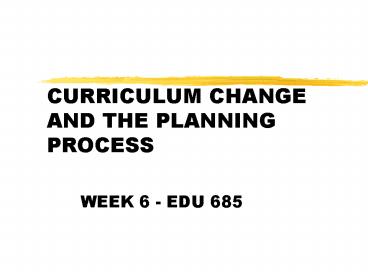CURRICULUM CHANGE AND THE PLANNING PROCESS PowerPoint PPT Presentation
1 / 31
Title: CURRICULUM CHANGE AND THE PLANNING PROCESS
1
CURRICULUM CHANGE AND THE PLANNING PROCESS
- WEEK 6 - EDU 685
2
MEANINGS
- Improvement
- Added value
- Excellence
- Enrichment
- Change
- Shift in position
3
IMPLEMENTATION
- A process that can be very technical or very
fluid and aesthetic - Alters knowledge, actions, and attitudes
- Requires time, personal interaction and contacts
- Requires in-service training
4
FACTORS IN PLANNING
- People
- Programs
- Processes
5
CHANGE!!
- WHO...
- ME??
6
INCREMENTALISM
- Time to try the new program
- Time to reflect on new goals and objectives
- Time to consider new contents and learning
experiences - Time to try out new tasks
7
COMMUNICATION
- Message processing between sender and receiver
- A two-way channel
- Formal
- Informal
8
SUPPORT
- In-service training
- Financial support
- Trusting relationship
- Peer support
9
GUIDELINES FOR CHANGE
- Innovations designed to improve student
achievement must be technically sound - Successful innovation requires change in the
structure of a traditional school - Innovation must be manageable and feasible for
the average teacher - Implementation of successful change efforts must
be organic rather than bureaucratic - Avoid the do something, do anything syndrome
10
THEORY OF CHANGE(Lovell and Wiles)
- Leadership
- Communication
- Release of human potential
- Problem solving
- Evaluation
11
THEORY OF CHANGE(Lewin)
- Driving Forces
- Governmental intervention
- Societys values
- Technological changes
- Knowledge explosion
- Administrative processes
- Restraining Forces
- Fear of unknown
- Threats to power or turf
- Obsolete knowledge or skills
- Traditional values
- Limited resources
12
STAGES OF CHANGE(Lewin)
- Current situation is unfrozen
- reduce restraining forces or
- increase driving forces
- Getting entity to move from unfrozen point A to
point B - effort
- Situation is frozen
- increase restraining forces or
- decrease driving forces
13
TYPES OF CHANGE(Bennis)
- Planned change
- equal power and function of those involved
- ideal
- Coercion
- controlled by one group
- unequal power balance is maintained
- Interaction change
- Mutual goal-setting
- Few procedures
14
RESISTANCE TO CHANGE
- Inertia
- Bureaucracy in place is safe haven
- Rapidity of change
- Lack of knowledge
15
OBSTACLES TO CHANGE(Harvey)
- Lack of ownership
- Lack of benefits
- Increased burdens
- Lack of administrative support
- Loneliness
- Insecurity
16
Obstacles, continued...
- Norm incongruence
- Boredom
- Chaos
- Differential knowledge
- Sudden wholesale change
- Unique points of resistance
17
STAGES OF IMPLEMENTATION
- Initiation
- Who will be involved?
- What support is needed?
- What is state of readiness?
18
Stages, continued...
- Implementation
- trying out the innovation
- putting various models or approaches into action
19
Stages, continued...
- Maintenance or institutionalization
- monitoring
20
ORC MODEL(Gross)
- Success or failure depends on leaders ability to
overcome staff resistance to change
21
DEVELOPMENTAL STAGES OF CHANGE
- Unrelated concerns
- Personal concerns
- Task-related concerns
- Impact-related concerns
22
CHANGE IS NOT SYNONYMOUS WITH IMPROVEMENT
23
THE PLANNING PROCESS
- Ideas about curriculum
- living documents
- categories of objective reality and mode and
style - has a life span
- formal and planned - and unplanned
- active and changing
24
CURRICULUM IMPROVEMENT
- Curriculum improvement refers not only to
improving the structure and the documents of the
curriculum but also to stimulating learning on
the part of all persons who are concerned with
the curriculum. - Doll, p. 358
25
EVOLUTION OF PLANNING
- Courses of study
- Top-down decisions
- Little involvement of teacher
26
TRENDS IN PLANNING
- Environments and people are part of planned
changes - Considered a necessity and continuing activity
- Activities vary in kinds and time
- Emerging practices change curriculum
27
trends, continued...
- Goals and objectives are foundation
- Teachers, students and lay persons are involved
- System dynamics affect problem solving
- Few changes after 1960s
28
CURRENT ISSUES TRENDS
- Quality of teachers administrators
- Retraining of personnel
- Real life vs textbook knowledge
- Shared decision-making
- Standards of excellence
- Schools vs outside organizations
- Local, state federal relationships
29
GOOD VS. EFFECTI VE SCHOOLS?
- Assess needs
- Solve problems created or raised by needs
- Involve teachers in the classroom
30
PRESSURES TO IMPROVE
- State and federal governments
- Private testing organizations
- Private foundations
- Textbook publishers
- Colleges and universities
- Labor unions
31
ULTIMATE PLANNING
- Better uses for
- Time
- Space
- Personnel

